Report: Supporting Use of Medication in Social Care Setting
VerifiedAdded on 2020/06/05
|9
|2317
|33
Report
AI Summary
This report delves into the critical aspects of supporting medication use within social care settings. It begins with an overview of relevant policies and legislation, including the Medication Act, Controlled Drugs Regulations, and the Care Quality Commission's standards. The report then outlines the roles and responsibilities of various healthcare professionals, such as care workers, registered managers, nurses, and pharmacists, in relation to medication management. It further explores how to access and document information about an individual's medication through tools like the Medication Administration Record (MAR) sheet and medical records. The report provides a detailed explanation of the different routes of medication administration, including oral, inhalation, injection, and rectal methods, as well as the various forms in which medication may be presented, such as tablets, capsules, liquids, and gases. Additionally, it discusses the use of equipment, such as compliance aids, monitored dosage systems, and inhalers, to assist in medication administration. The report also covers the data that must be recorded about medication use, safe storage practices for different medications, and the proper disposal of unused or unwanted medications. The conclusion emphasizes the importance of comprehensive knowledge regarding medication support for individuals working in social care homes.
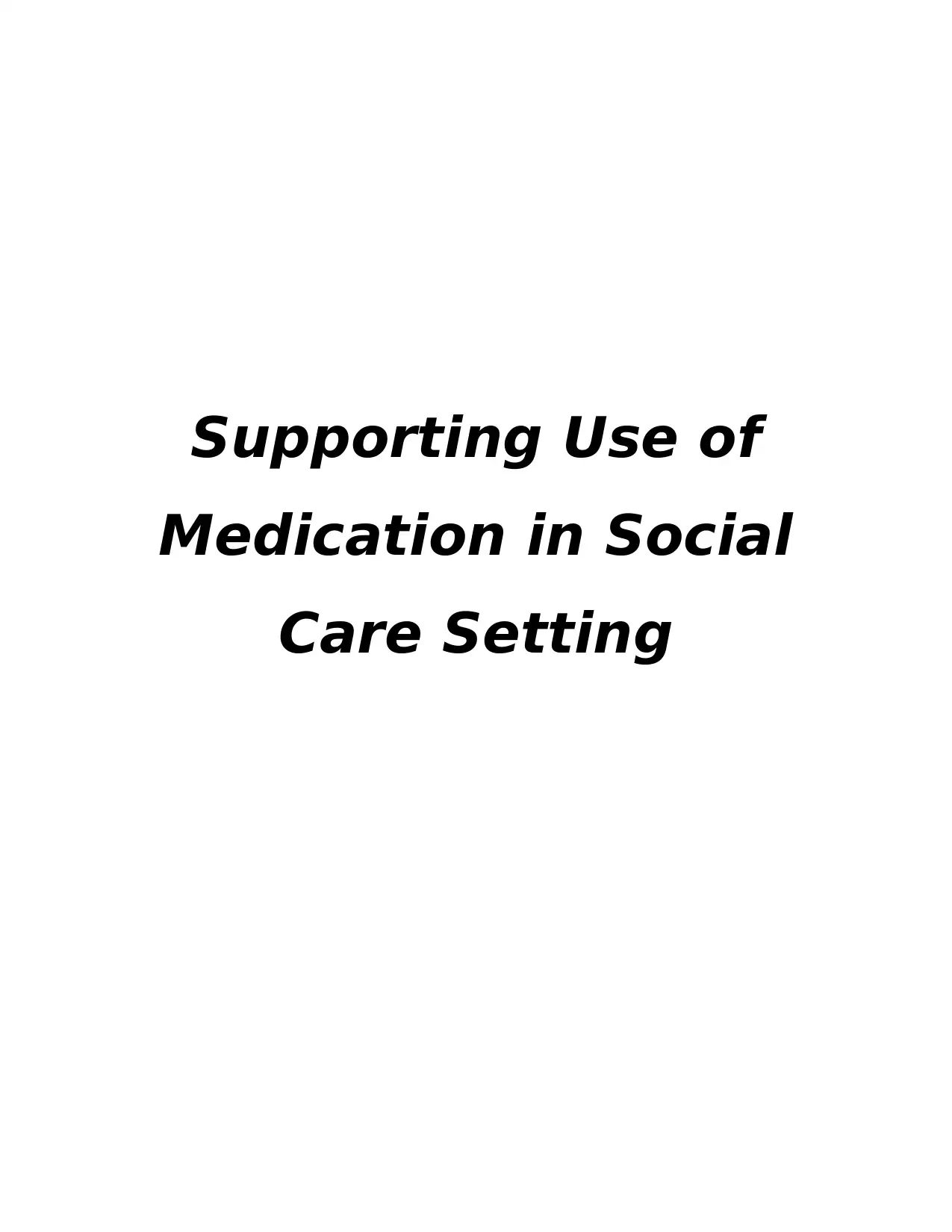
Supporting Use of
Medication in Social
Care Setting
Medication in Social
Care Setting
Paraphrase This Document
Need a fresh take? Get an instant paraphrase of this document with our AI Paraphraser
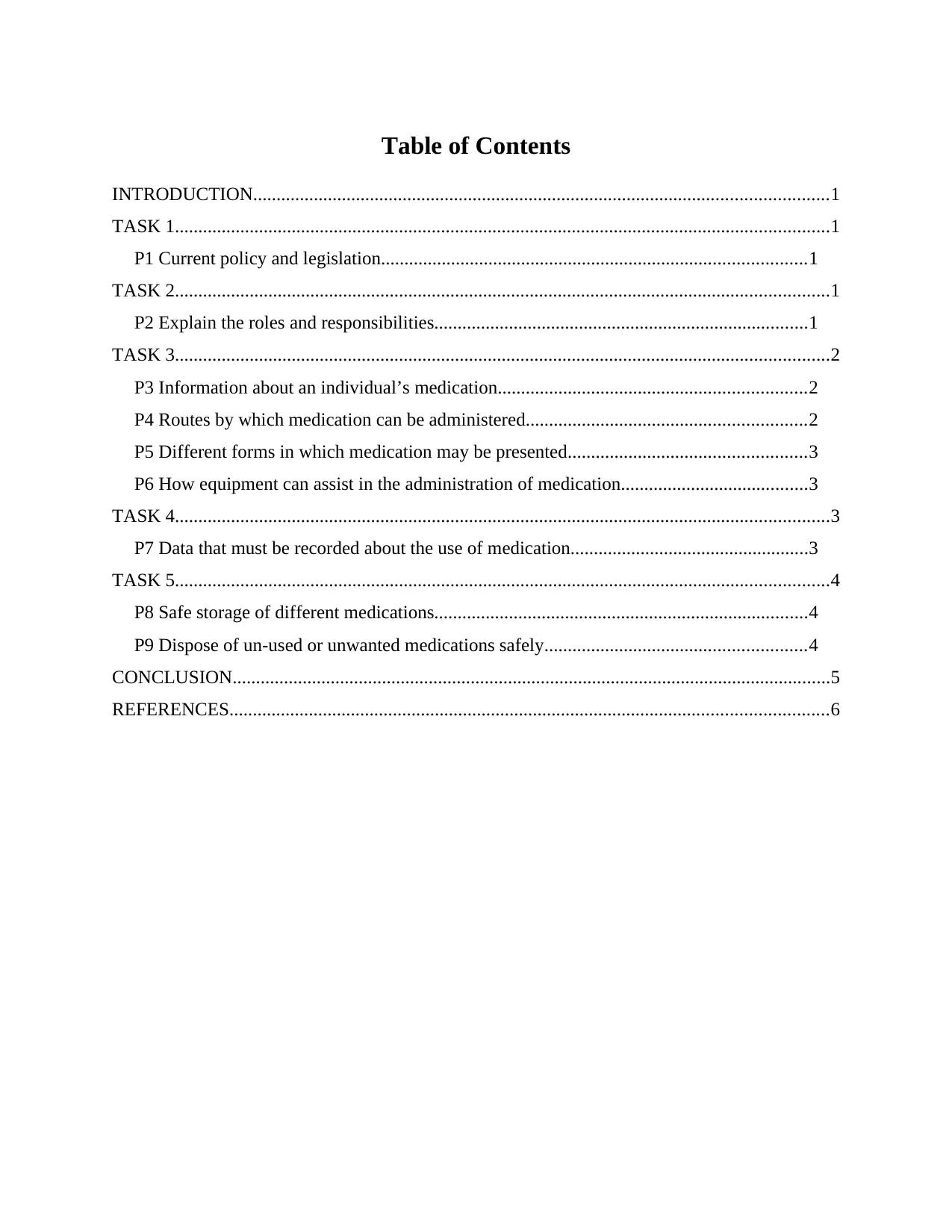
Table of Contents
INTRODUCTION...........................................................................................................................1
TASK 1............................................................................................................................................1
P1 Current policy and legislation...........................................................................................1
TASK 2............................................................................................................................................1
P2 Explain the roles and responsibilities................................................................................1
TASK 3............................................................................................................................................2
P3 Information about an individual’s medication..................................................................2
P4 Routes by which medication can be administered............................................................2
P5 Different forms in which medication may be presented...................................................3
P6 How equipment can assist in the administration of medication........................................3
TASK 4............................................................................................................................................3
P7 Data that must be recorded about the use of medication...................................................3
TASK 5............................................................................................................................................4
P8 Safe storage of different medications................................................................................4
P9 Dispose of un-used or unwanted medications safely........................................................4
CONCLUSION................................................................................................................................5
REFERENCES................................................................................................................................6
INTRODUCTION...........................................................................................................................1
TASK 1............................................................................................................................................1
P1 Current policy and legislation...........................................................................................1
TASK 2............................................................................................................................................1
P2 Explain the roles and responsibilities................................................................................1
TASK 3............................................................................................................................................2
P3 Information about an individual’s medication..................................................................2
P4 Routes by which medication can be administered............................................................2
P5 Different forms in which medication may be presented...................................................3
P6 How equipment can assist in the administration of medication........................................3
TASK 4............................................................................................................................................3
P7 Data that must be recorded about the use of medication...................................................3
TASK 5............................................................................................................................................4
P8 Safe storage of different medications................................................................................4
P9 Dispose of un-used or unwanted medications safely........................................................4
CONCLUSION................................................................................................................................5
REFERENCES................................................................................................................................6

⊘ This is a preview!⊘
Do you want full access?
Subscribe today to unlock all pages.

Trusted by 1+ million students worldwide
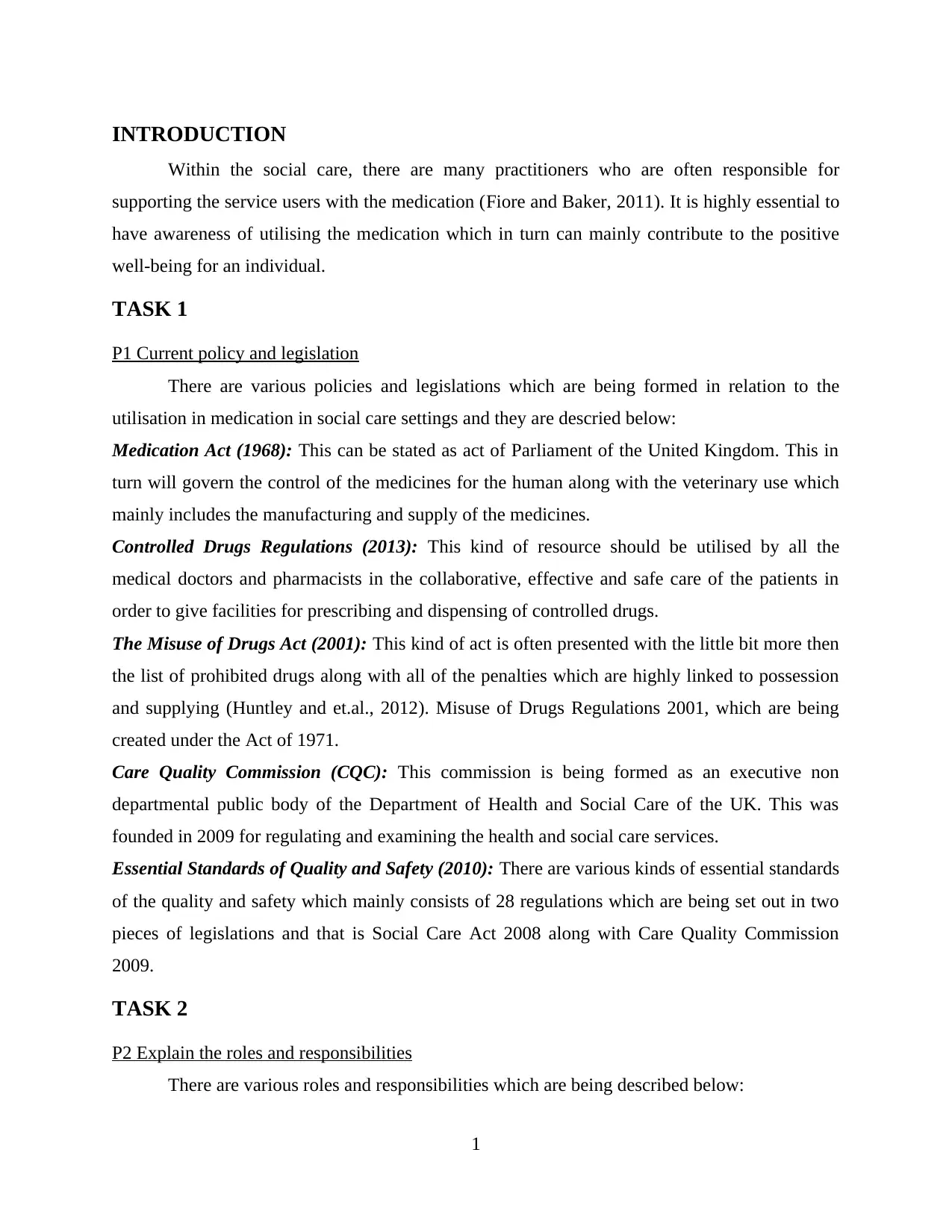
INTRODUCTION
Within the social care, there are many practitioners who are often responsible for
supporting the service users with the medication (Fiore and Baker, 2011). It is highly essential to
have awareness of utilising the medication which in turn can mainly contribute to the positive
well-being for an individual.
TASK 1
P1 Current policy and legislation
There are various policies and legislations which are being formed in relation to the
utilisation in medication in social care settings and they are descried below:
Medication Act (1968): This can be stated as act of Parliament of the United Kingdom. This in
turn will govern the control of the medicines for the human along with the veterinary use which
mainly includes the manufacturing and supply of the medicines.
Controlled Drugs Regulations (2013): This kind of resource should be utilised by all the
medical doctors and pharmacists in the collaborative, effective and safe care of the patients in
order to give facilities for prescribing and dispensing of controlled drugs.
The Misuse of Drugs Act (2001): This kind of act is often presented with the little bit more then
the list of prohibited drugs along with all of the penalties which are highly linked to possession
and supplying (Huntley and et.al., 2012). Misuse of Drugs Regulations 2001, which are being
created under the Act of 1971.
Care Quality Commission (CQC): This commission is being formed as an executive non
departmental public body of the Department of Health and Social Care of the UK. This was
founded in 2009 for regulating and examining the health and social care services.
Essential Standards of Quality and Safety (2010): There are various kinds of essential standards
of the quality and safety which mainly consists of 28 regulations which are being set out in two
pieces of legislations and that is Social Care Act 2008 along with Care Quality Commission
2009.
TASK 2
P2 Explain the roles and responsibilities
There are various roles and responsibilities which are being described below:
1
Within the social care, there are many practitioners who are often responsible for
supporting the service users with the medication (Fiore and Baker, 2011). It is highly essential to
have awareness of utilising the medication which in turn can mainly contribute to the positive
well-being for an individual.
TASK 1
P1 Current policy and legislation
There are various policies and legislations which are being formed in relation to the
utilisation in medication in social care settings and they are descried below:
Medication Act (1968): This can be stated as act of Parliament of the United Kingdom. This in
turn will govern the control of the medicines for the human along with the veterinary use which
mainly includes the manufacturing and supply of the medicines.
Controlled Drugs Regulations (2013): This kind of resource should be utilised by all the
medical doctors and pharmacists in the collaborative, effective and safe care of the patients in
order to give facilities for prescribing and dispensing of controlled drugs.
The Misuse of Drugs Act (2001): This kind of act is often presented with the little bit more then
the list of prohibited drugs along with all of the penalties which are highly linked to possession
and supplying (Huntley and et.al., 2012). Misuse of Drugs Regulations 2001, which are being
created under the Act of 1971.
Care Quality Commission (CQC): This commission is being formed as an executive non
departmental public body of the Department of Health and Social Care of the UK. This was
founded in 2009 for regulating and examining the health and social care services.
Essential Standards of Quality and Safety (2010): There are various kinds of essential standards
of the quality and safety which mainly consists of 28 regulations which are being set out in two
pieces of legislations and that is Social Care Act 2008 along with Care Quality Commission
2009.
TASK 2
P2 Explain the roles and responsibilities
There are various roles and responsibilities which are being described below:
1
Paraphrase This Document
Need a fresh take? Get an instant paraphrase of this document with our AI Paraphraser
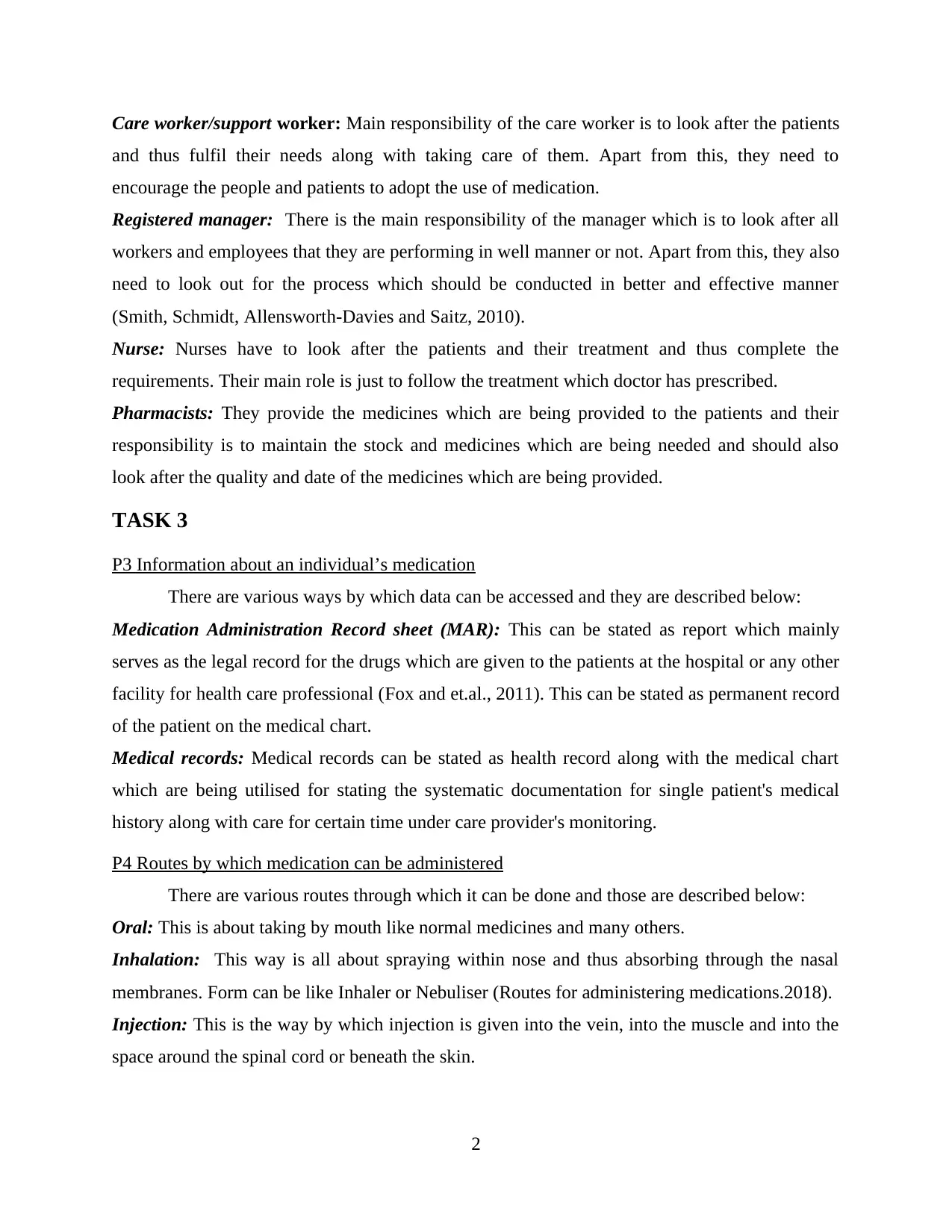
Care worker/support worker: Main responsibility of the care worker is to look after the patients
and thus fulfil their needs along with taking care of them. Apart from this, they need to
encourage the people and patients to adopt the use of medication.
Registered manager: There is the main responsibility of the manager which is to look after all
workers and employees that they are performing in well manner or not. Apart from this, they also
need to look out for the process which should be conducted in better and effective manner
(Smith, Schmidt, Allensworth-Davies and Saitz, 2010).
Nurse: Nurses have to look after the patients and their treatment and thus complete the
requirements. Their main role is just to follow the treatment which doctor has prescribed.
Pharmacists: They provide the medicines which are being provided to the patients and their
responsibility is to maintain the stock and medicines which are being needed and should also
look after the quality and date of the medicines which are being provided.
TASK 3
P3 Information about an individual’s medication
There are various ways by which data can be accessed and they are described below:
Medication Administration Record sheet (MAR): This can be stated as report which mainly
serves as the legal record for the drugs which are given to the patients at the hospital or any other
facility for health care professional (Fox and et.al., 2011). This can be stated as permanent record
of the patient on the medical chart.
Medical records: Medical records can be stated as health record along with the medical chart
which are being utilised for stating the systematic documentation for single patient's medical
history along with care for certain time under care provider's monitoring.
P4 Routes by which medication can be administered
There are various routes through which it can be done and those are described below:
Oral: This is about taking by mouth like normal medicines and many others.
Inhalation: This way is all about spraying within nose and thus absorbing through the nasal
membranes. Form can be like Inhaler or Nebuliser (Routes for administering medications.2018).
Injection: This is the way by which injection is given into the vein, into the muscle and into the
space around the spinal cord or beneath the skin.
2
and thus fulfil their needs along with taking care of them. Apart from this, they need to
encourage the people and patients to adopt the use of medication.
Registered manager: There is the main responsibility of the manager which is to look after all
workers and employees that they are performing in well manner or not. Apart from this, they also
need to look out for the process which should be conducted in better and effective manner
(Smith, Schmidt, Allensworth-Davies and Saitz, 2010).
Nurse: Nurses have to look after the patients and their treatment and thus complete the
requirements. Their main role is just to follow the treatment which doctor has prescribed.
Pharmacists: They provide the medicines which are being provided to the patients and their
responsibility is to maintain the stock and medicines which are being needed and should also
look after the quality and date of the medicines which are being provided.
TASK 3
P3 Information about an individual’s medication
There are various ways by which data can be accessed and they are described below:
Medication Administration Record sheet (MAR): This can be stated as report which mainly
serves as the legal record for the drugs which are given to the patients at the hospital or any other
facility for health care professional (Fox and et.al., 2011). This can be stated as permanent record
of the patient on the medical chart.
Medical records: Medical records can be stated as health record along with the medical chart
which are being utilised for stating the systematic documentation for single patient's medical
history along with care for certain time under care provider's monitoring.
P4 Routes by which medication can be administered
There are various routes through which it can be done and those are described below:
Oral: This is about taking by mouth like normal medicines and many others.
Inhalation: This way is all about spraying within nose and thus absorbing through the nasal
membranes. Form can be like Inhaler or Nebuliser (Routes for administering medications.2018).
Injection: This is the way by which injection is given into the vein, into the muscle and into the
space around the spinal cord or beneath the skin.
2
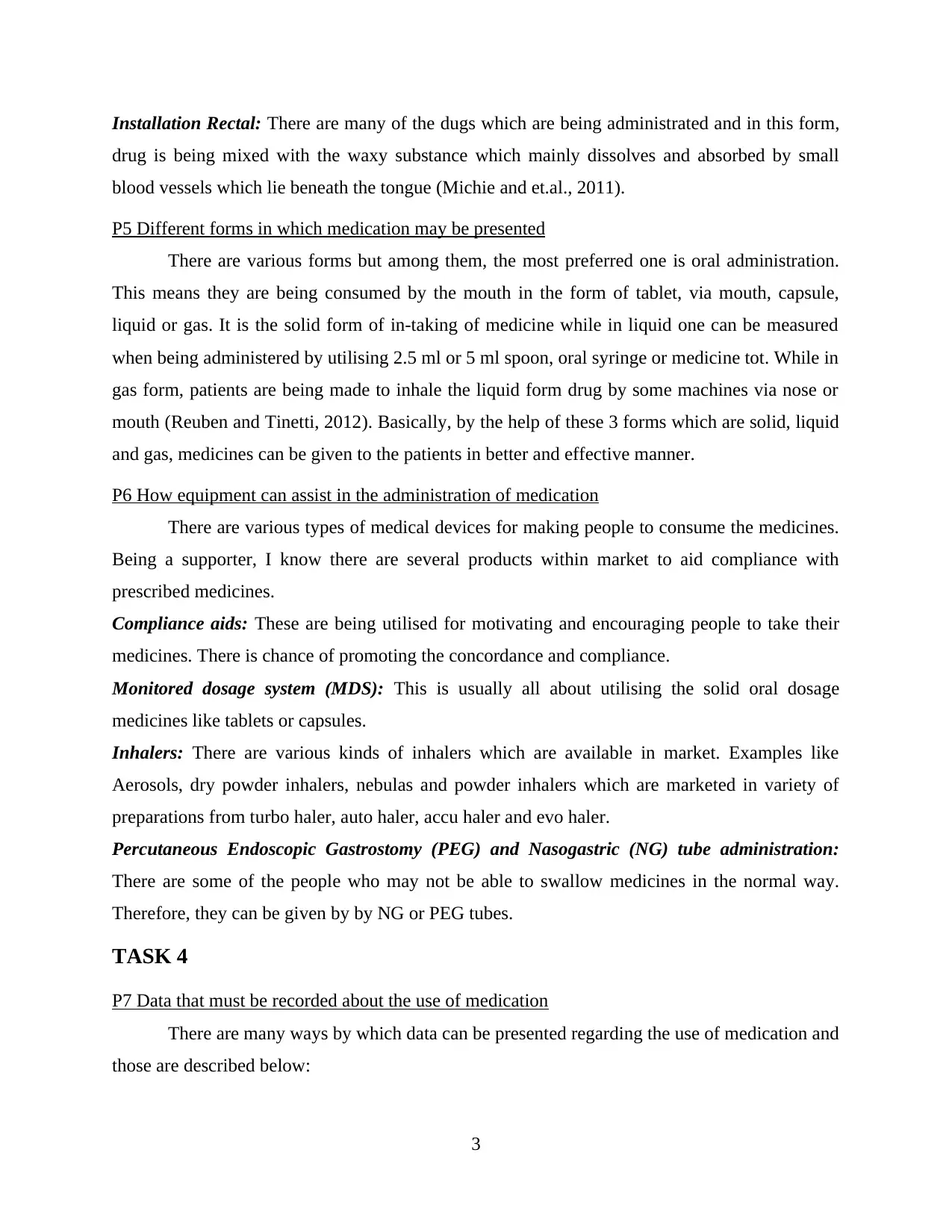
Installation Rectal: There are many of the dugs which are being administrated and in this form,
drug is being mixed with the waxy substance which mainly dissolves and absorbed by small
blood vessels which lie beneath the tongue (Michie and et.al., 2011).
P5 Different forms in which medication may be presented
There are various forms but among them, the most preferred one is oral administration.
This means they are being consumed by the mouth in the form of tablet, via mouth, capsule,
liquid or gas. It is the solid form of in-taking of medicine while in liquid one can be measured
when being administered by utilising 2.5 ml or 5 ml spoon, oral syringe or medicine tot. While in
gas form, patients are being made to inhale the liquid form drug by some machines via nose or
mouth (Reuben and Tinetti, 2012). Basically, by the help of these 3 forms which are solid, liquid
and gas, medicines can be given to the patients in better and effective manner.
P6 How equipment can assist in the administration of medication
There are various types of medical devices for making people to consume the medicines.
Being a supporter, I know there are several products within market to aid compliance with
prescribed medicines.
Compliance aids: These are being utilised for motivating and encouraging people to take their
medicines. There is chance of promoting the concordance and compliance.
Monitored dosage system (MDS): This is usually all about utilising the solid oral dosage
medicines like tablets or capsules.
Inhalers: There are various kinds of inhalers which are available in market. Examples like
Aerosols, dry powder inhalers, nebulas and powder inhalers which are marketed in variety of
preparations from turbo haler, auto haler, accu haler and evo haler.
Percutaneous Endoscopic Gastrostomy (PEG) and Nasogastric (NG) tube administration:
There are some of the people who may not be able to swallow medicines in the normal way.
Therefore, they can be given by by NG or PEG tubes.
TASK 4
P7 Data that must be recorded about the use of medication
There are many ways by which data can be presented regarding the use of medication and
those are described below:
3
drug is being mixed with the waxy substance which mainly dissolves and absorbed by small
blood vessels which lie beneath the tongue (Michie and et.al., 2011).
P5 Different forms in which medication may be presented
There are various forms but among them, the most preferred one is oral administration.
This means they are being consumed by the mouth in the form of tablet, via mouth, capsule,
liquid or gas. It is the solid form of in-taking of medicine while in liquid one can be measured
when being administered by utilising 2.5 ml or 5 ml spoon, oral syringe or medicine tot. While in
gas form, patients are being made to inhale the liquid form drug by some machines via nose or
mouth (Reuben and Tinetti, 2012). Basically, by the help of these 3 forms which are solid, liquid
and gas, medicines can be given to the patients in better and effective manner.
P6 How equipment can assist in the administration of medication
There are various types of medical devices for making people to consume the medicines.
Being a supporter, I know there are several products within market to aid compliance with
prescribed medicines.
Compliance aids: These are being utilised for motivating and encouraging people to take their
medicines. There is chance of promoting the concordance and compliance.
Monitored dosage system (MDS): This is usually all about utilising the solid oral dosage
medicines like tablets or capsules.
Inhalers: There are various kinds of inhalers which are available in market. Examples like
Aerosols, dry powder inhalers, nebulas and powder inhalers which are marketed in variety of
preparations from turbo haler, auto haler, accu haler and evo haler.
Percutaneous Endoscopic Gastrostomy (PEG) and Nasogastric (NG) tube administration:
There are some of the people who may not be able to swallow medicines in the normal way.
Therefore, they can be given by by NG or PEG tubes.
TASK 4
P7 Data that must be recorded about the use of medication
There are many ways by which data can be presented regarding the use of medication and
those are described below:
3
⊘ This is a preview!⊘
Do you want full access?
Subscribe today to unlock all pages.

Trusted by 1+ million students worldwide
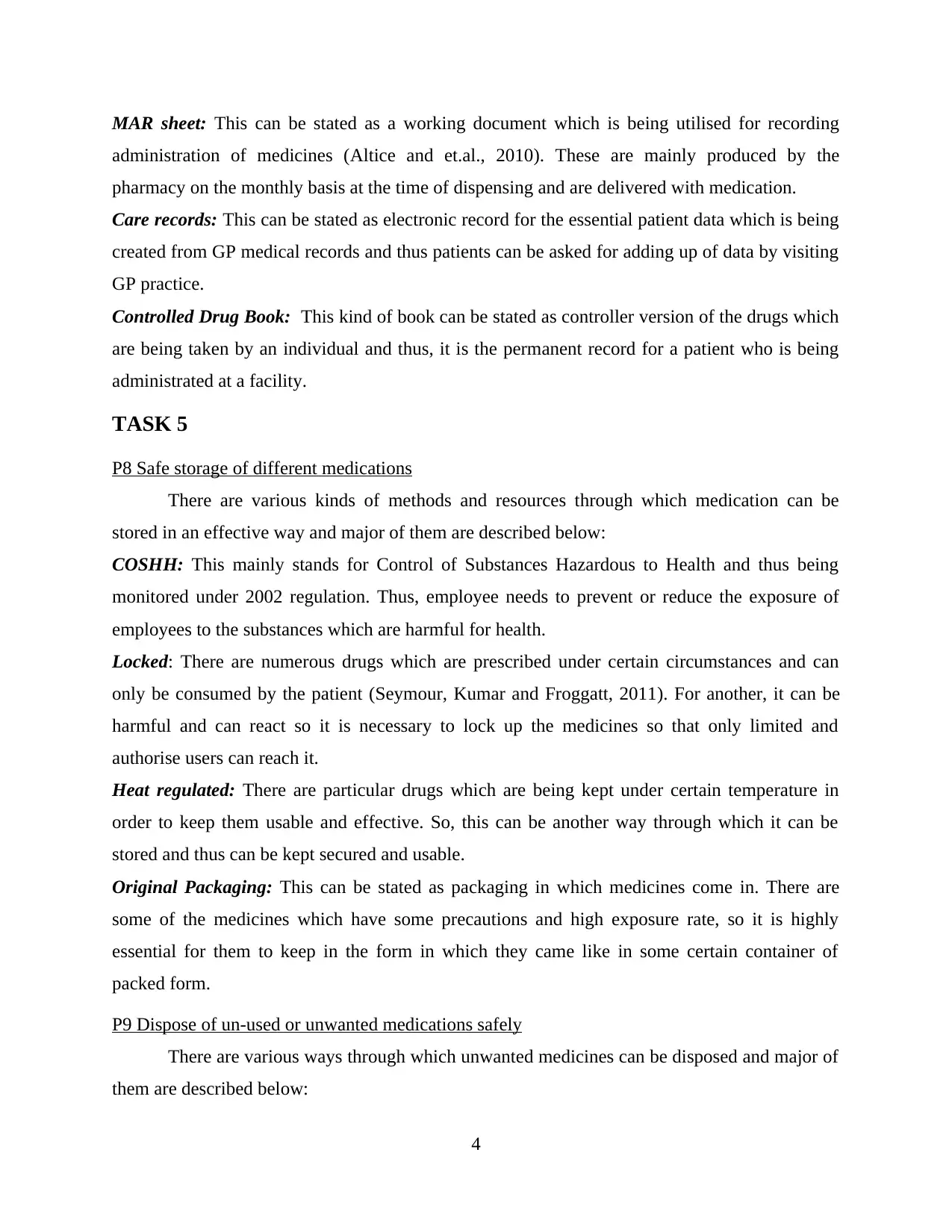
MAR sheet: This can be stated as a working document which is being utilised for recording
administration of medicines (Altice and et.al., 2010). These are mainly produced by the
pharmacy on the monthly basis at the time of dispensing and are delivered with medication.
Care records: This can be stated as electronic record for the essential patient data which is being
created from GP medical records and thus patients can be asked for adding up of data by visiting
GP practice.
Controlled Drug Book: This kind of book can be stated as controller version of the drugs which
are being taken by an individual and thus, it is the permanent record for a patient who is being
administrated at a facility.
TASK 5
P8 Safe storage of different medications
There are various kinds of methods and resources through which medication can be
stored in an effective way and major of them are described below:
COSHH: This mainly stands for Control of Substances Hazardous to Health and thus being
monitored under 2002 regulation. Thus, employee needs to prevent or reduce the exposure of
employees to the substances which are harmful for health.
Locked: There are numerous drugs which are prescribed under certain circumstances and can
only be consumed by the patient (Seymour, Kumar and Froggatt, 2011). For another, it can be
harmful and can react so it is necessary to lock up the medicines so that only limited and
authorise users can reach it.
Heat regulated: There are particular drugs which are being kept under certain temperature in
order to keep them usable and effective. So, this can be another way through which it can be
stored and thus can be kept secured and usable.
Original Packaging: This can be stated as packaging in which medicines come in. There are
some of the medicines which have some precautions and high exposure rate, so it is highly
essential for them to keep in the form in which they came like in some certain container of
packed form.
P9 Dispose of un-used or unwanted medications safely
There are various ways through which unwanted medicines can be disposed and major of
them are described below:
4
administration of medicines (Altice and et.al., 2010). These are mainly produced by the
pharmacy on the monthly basis at the time of dispensing and are delivered with medication.
Care records: This can be stated as electronic record for the essential patient data which is being
created from GP medical records and thus patients can be asked for adding up of data by visiting
GP practice.
Controlled Drug Book: This kind of book can be stated as controller version of the drugs which
are being taken by an individual and thus, it is the permanent record for a patient who is being
administrated at a facility.
TASK 5
P8 Safe storage of different medications
There are various kinds of methods and resources through which medication can be
stored in an effective way and major of them are described below:
COSHH: This mainly stands for Control of Substances Hazardous to Health and thus being
monitored under 2002 regulation. Thus, employee needs to prevent or reduce the exposure of
employees to the substances which are harmful for health.
Locked: There are numerous drugs which are prescribed under certain circumstances and can
only be consumed by the patient (Seymour, Kumar and Froggatt, 2011). For another, it can be
harmful and can react so it is necessary to lock up the medicines so that only limited and
authorise users can reach it.
Heat regulated: There are particular drugs which are being kept under certain temperature in
order to keep them usable and effective. So, this can be another way through which it can be
stored and thus can be kept secured and usable.
Original Packaging: This can be stated as packaging in which medicines come in. There are
some of the medicines which have some precautions and high exposure rate, so it is highly
essential for them to keep in the form in which they came like in some certain container of
packed form.
P9 Dispose of un-used or unwanted medications safely
There are various ways through which unwanted medicines can be disposed and major of
them are described below:
4
Paraphrase This Document
Need a fresh take? Get an instant paraphrase of this document with our AI Paraphraser
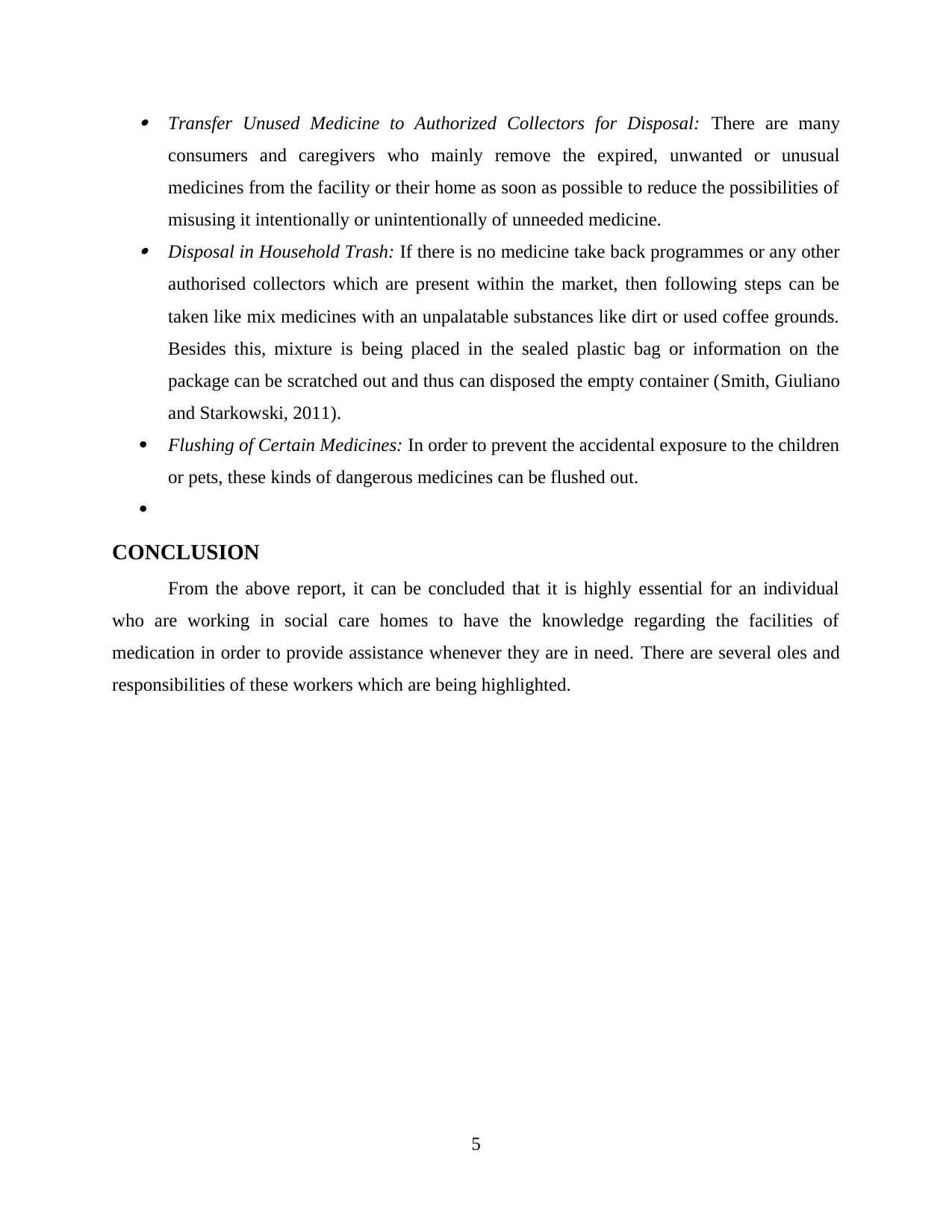
Transfer Unused Medicine to Authorized Collectors for Disposal: There are many
consumers and caregivers who mainly remove the expired, unwanted or unusual
medicines from the facility or their home as soon as possible to reduce the possibilities of
misusing it intentionally or unintentionally of unneeded medicine. Disposal in Household Trash: If there is no medicine take back programmes or any other
authorised collectors which are present within the market, then following steps can be
taken like mix medicines with an unpalatable substances like dirt or used coffee grounds.
Besides this, mixture is being placed in the sealed plastic bag or information on the
package can be scratched out and thus can disposed the empty container (Smith, Giuliano
and Starkowski, 2011).
Flushing of Certain Medicines: In order to prevent the accidental exposure to the children
or pets, these kinds of dangerous medicines can be flushed out.
CONCLUSION
From the above report, it can be concluded that it is highly essential for an individual
who are working in social care homes to have the knowledge regarding the facilities of
medication in order to provide assistance whenever they are in need. There are several oles and
responsibilities of these workers which are being highlighted.
5
consumers and caregivers who mainly remove the expired, unwanted or unusual
medicines from the facility or their home as soon as possible to reduce the possibilities of
misusing it intentionally or unintentionally of unneeded medicine. Disposal in Household Trash: If there is no medicine take back programmes or any other
authorised collectors which are present within the market, then following steps can be
taken like mix medicines with an unpalatable substances like dirt or used coffee grounds.
Besides this, mixture is being placed in the sealed plastic bag or information on the
package can be scratched out and thus can disposed the empty container (Smith, Giuliano
and Starkowski, 2011).
Flushing of Certain Medicines: In order to prevent the accidental exposure to the children
or pets, these kinds of dangerous medicines can be flushed out.
CONCLUSION
From the above report, it can be concluded that it is highly essential for an individual
who are working in social care homes to have the knowledge regarding the facilities of
medication in order to provide assistance whenever they are in need. There are several oles and
responsibilities of these workers which are being highlighted.
5
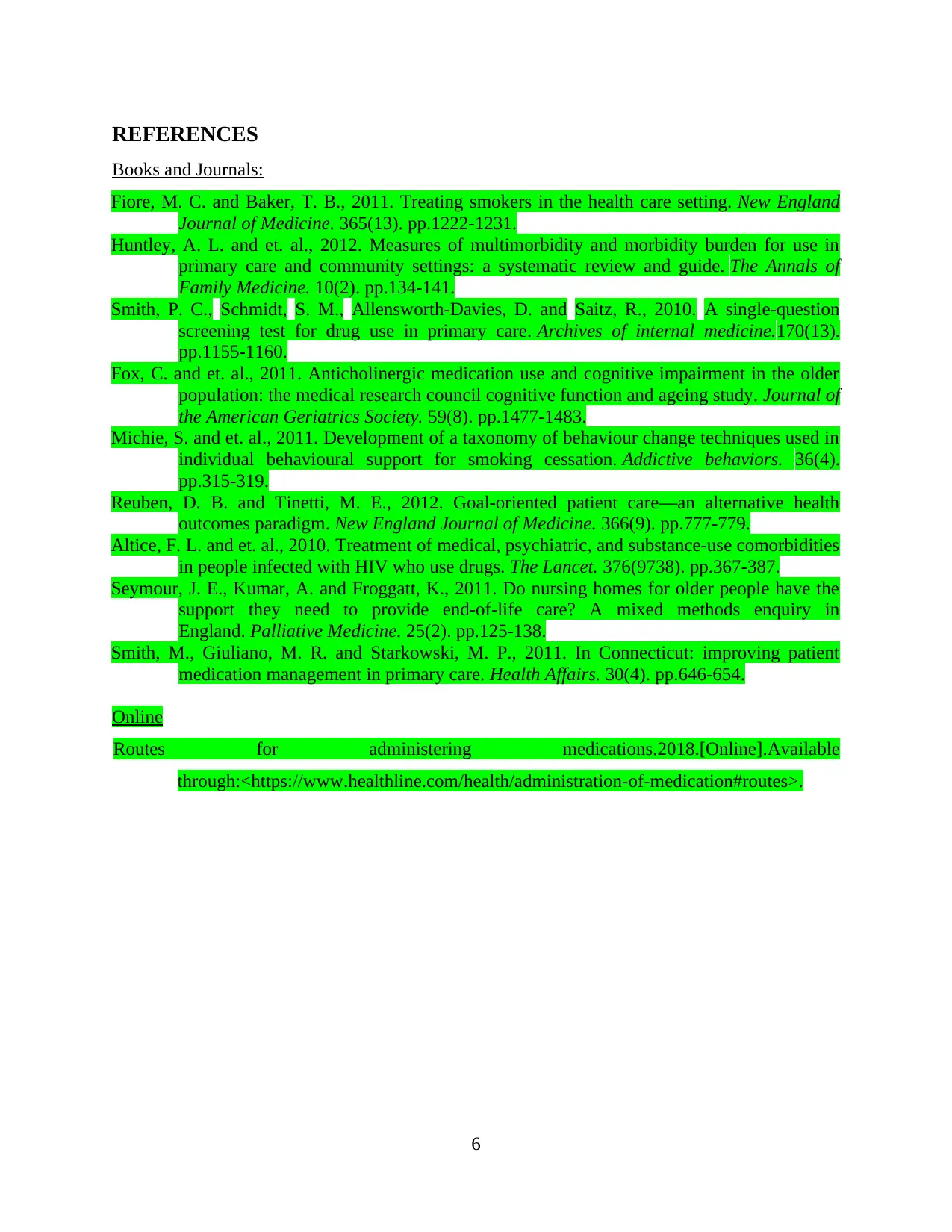
REFERENCES
Books and Journals:
Fiore, M. C. and Baker, T. B., 2011. Treating smokers in the health care setting. New England
Journal of Medicine. 365(13). pp.1222-1231.
Huntley, A. L. and et. al., 2012. Measures of multimorbidity and morbidity burden for use in
primary care and community settings: a systematic review and guide. The Annals of
Family Medicine. 10(2). pp.134-141.
Smith, P. C., Schmidt, S. M., Allensworth-Davies, D. and Saitz, R., 2010. A single-question
screening test for drug use in primary care. Archives of internal medicine.170(13).
pp.1155-1160.
Fox, C. and et. al., 2011. Anticholinergic medication use and cognitive impairment in the older
population: the medical research council cognitive function and ageing study. Journal of
the American Geriatrics Society. 59(8). pp.1477-1483.
Michie, S. and et. al., 2011. Development of a taxonomy of behaviour change techniques used in
individual behavioural support for smoking cessation. Addictive behaviors. 36(4).
pp.315-319.
Reuben, D. B. and Tinetti, M. E., 2012. Goal-oriented patient care—an alternative health
outcomes paradigm. New England Journal of Medicine. 366(9). pp.777-779.
Altice, F. L. and et. al., 2010. Treatment of medical, psychiatric, and substance-use comorbidities
in people infected with HIV who use drugs. The Lancet. 376(9738). pp.367-387.
Seymour, J. E., Kumar, A. and Froggatt, K., 2011. Do nursing homes for older people have the
support they need to provide end-of-life care? A mixed methods enquiry in
England. Palliative Medicine. 25(2). pp.125-138.
Smith, M., Giuliano, M. R. and Starkowski, M. P., 2011. In Connecticut: improving patient
medication management in primary care. Health Affairs. 30(4). pp.646-654.
Online
Routes for administering medications.2018.[Online].Available
through:<https://www.healthline.com/health/administration-of-medication#routes>.
6
Books and Journals:
Fiore, M. C. and Baker, T. B., 2011. Treating smokers in the health care setting. New England
Journal of Medicine. 365(13). pp.1222-1231.
Huntley, A. L. and et. al., 2012. Measures of multimorbidity and morbidity burden for use in
primary care and community settings: a systematic review and guide. The Annals of
Family Medicine. 10(2). pp.134-141.
Smith, P. C., Schmidt, S. M., Allensworth-Davies, D. and Saitz, R., 2010. A single-question
screening test for drug use in primary care. Archives of internal medicine.170(13).
pp.1155-1160.
Fox, C. and et. al., 2011. Anticholinergic medication use and cognitive impairment in the older
population: the medical research council cognitive function and ageing study. Journal of
the American Geriatrics Society. 59(8). pp.1477-1483.
Michie, S. and et. al., 2011. Development of a taxonomy of behaviour change techniques used in
individual behavioural support for smoking cessation. Addictive behaviors. 36(4).
pp.315-319.
Reuben, D. B. and Tinetti, M. E., 2012. Goal-oriented patient care—an alternative health
outcomes paradigm. New England Journal of Medicine. 366(9). pp.777-779.
Altice, F. L. and et. al., 2010. Treatment of medical, psychiatric, and substance-use comorbidities
in people infected with HIV who use drugs. The Lancet. 376(9738). pp.367-387.
Seymour, J. E., Kumar, A. and Froggatt, K., 2011. Do nursing homes for older people have the
support they need to provide end-of-life care? A mixed methods enquiry in
England. Palliative Medicine. 25(2). pp.125-138.
Smith, M., Giuliano, M. R. and Starkowski, M. P., 2011. In Connecticut: improving patient
medication management in primary care. Health Affairs. 30(4). pp.646-654.
Online
Routes for administering medications.2018.[Online].Available
through:<https://www.healthline.com/health/administration-of-medication#routes>.
6
⊘ This is a preview!⊘
Do you want full access?
Subscribe today to unlock all pages.

Trusted by 1+ million students worldwide
1 out of 9
Related Documents
Your All-in-One AI-Powered Toolkit for Academic Success.
+13062052269
info@desklib.com
Available 24*7 on WhatsApp / Email
![[object Object]](/_next/static/media/star-bottom.7253800d.svg)
Unlock your academic potential
Copyright © 2020–2025 A2Z Services. All Rights Reserved. Developed and managed by ZUCOL.





